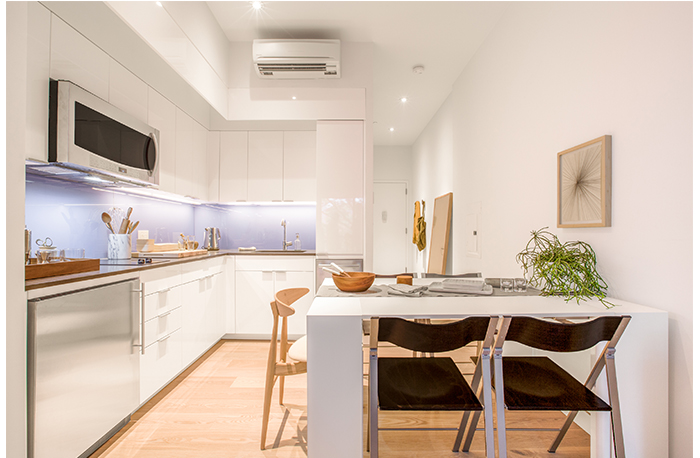The Coming Housing Revolution

October 3, 2016
The Florim Showroom and the International Furnishings and Design Association (IFDA) in New York City recently hosted an evening panel with experts identifying three distinct new interior design trends. The evening was facilitated to help design experts determine which fits their business model best and how they can recognize and capitalize on opportunities with the new transitions to housing and design. The IFDA invited speakers to present the three strongest directions: small spaces, multi-generational homes and luxury housing. The event was moderated by Hermine Mariaux, IFDA board member and trend analyst, and the presenters included Kim Ashbaugh, director of Next Gen Brand Management for Lennar; Chris Bledsoe, founding partner of Ollie/Stage 3 Properties; and designers Geoffrey Bradfield and his business partner, Roric Tobin. Small Spaces Bledsoe discussed micro apartments with community minded communal spaces. The micro apartment trend began several years ago yet began with limited thought to interior design and resulted in ill-fitting materials and furnishings. With more cities needing rent prices to be more relative to income, there is a movement toward micro apartments – often giving a much cheaper alternative of up to 15-20 percent less in rent. Three out of four renters for small spaces are millennials, who prefer experiences over things and are familiar with communal-like services thanks to business formulas like Uber, Airbnb and Pod Hotel. However, a target market that should not be overlooked is the baby boomer – often the other 25 percent of micro unit renters searching out high design and accessibility in a city environment. Bledsoe was part of the design and development of the first micro unit apartments in New York City, ranging in size from 220 to 360 square feet. The goal was to not only design a pleasing aesthetic but ensure livability. The micro apartments are furnished predominantly by Resource Furniture, a company known for space-saving and high design solutions. Much of the multi-use furniture is effective enough to permit 300 square feet to work like 600. As more residents are living in smaller spaces, it became prudent to encourage more interaction in the communal living areas of the apartment building. A live-in community manager helps “activate” these sets of services and amenities (including WiFi, cable, housekeeping, butler services, pop-up dinners, game nights, etc.) to help provide a sense of comfort and community. Multi-Generational Living Ashbaugh discussed how multi-generational living may be a new development for our society but has long been practiced in other cultures. Since the 1880s, there hasn’t been a group so burdened by student loans or making starting salaries than now. Approximately 60 million Americans are living with their parents into their early 30s. She also noted that this generation is seeking more communal services and human interactions often lost to technology. The other catch phrase – Sandwich Generation – refers to the parents of these millennials, who are now taking care of ailing parents and their millennial children by providing housing. It is now more often the case for several generations to be under one roof, or even groups of friends to live in multi-occupational homes. When considering the design of these new multi-family homes Ashbaugh identified four key factors: 1. Privacy – separate yet connected. Maintain independence for the young adult and the grandparent; separate living spaces, bathrooms, kitchenettes. 2. Flexibility. Think now about what the future will bring and plan for it. Use suites for present needs and anticipate future requirements for an aging parent. Start the conversations early with your family. 3. Livability. Consider furniture and design features to function in a smaller space, such as cabinet heights, sound proofing, multi-zone air conditioning, outdoor living spaces, etc. Universal design won’t always work as well in more compact spaces. It’s also important to consider natural light, as windows are often a second thought. 4. Reduction of expenses. There is a bonus to sharing household expenses; perhaps consider a built-in baby sitter or dog sitter. According to Ashbaugh, the lessons learned by working on multi-generational homes are the amazing flexibility of family, the peace of mind they felt and the family bonds they created. Luxury Housing Geoffrey Bradfield and his business partner Roric Tobin discussed the specific niche market of the very wealthy, who own 77 percent of all disposable income in the U.S. This design team’s clientele is the forgotten demographic of those 55 and older with the highest level of disposable income. There is much potential in this untapped market. Their clients demand the highest professional standards, quality of work and a knowledge of fine arts and antiques. “Often art predicates design, and originality is key,” said Bradfield. Clients at this level develop such a keen eye for collecting, so it’s important to form a connection with them to truly identify their tastes. Bradfield has been successful in these philosophies, often staying generations with a family, including designing 17 homes for one. Many clients have several houses all over the world, and it’s important to consider the environments of each location. The key is to recognize that clients wish for an expression and reflection of who they are. More often than not, the art collections are unique and refined; clients don’t want cookie-cutter items, they desire originality. Art is often a focal point, however, practicality must play into it too.
By Helene Taylor
More News
April 26, 2024 | Business, Trends & Inspirations
Personalization Is Defining Today’s Luxury Projects
April 26, 2024 | Business
PIRCH Permanently Shuts Down, Files for Bankruptcy
April 25, 2024 | Awards & Events
2024 Coverings Installation & Design Award Winners Announced
April 24, 2024 | People
Oatey Announces New COO and CCO
April 23, 2024 | Trends & Inspirations
Sustainability Report: More Education Needed for Green K&B Design
April 2, 2024 | Sponsored
Whirlpool Corp. Brings Purposeful Innovation Home